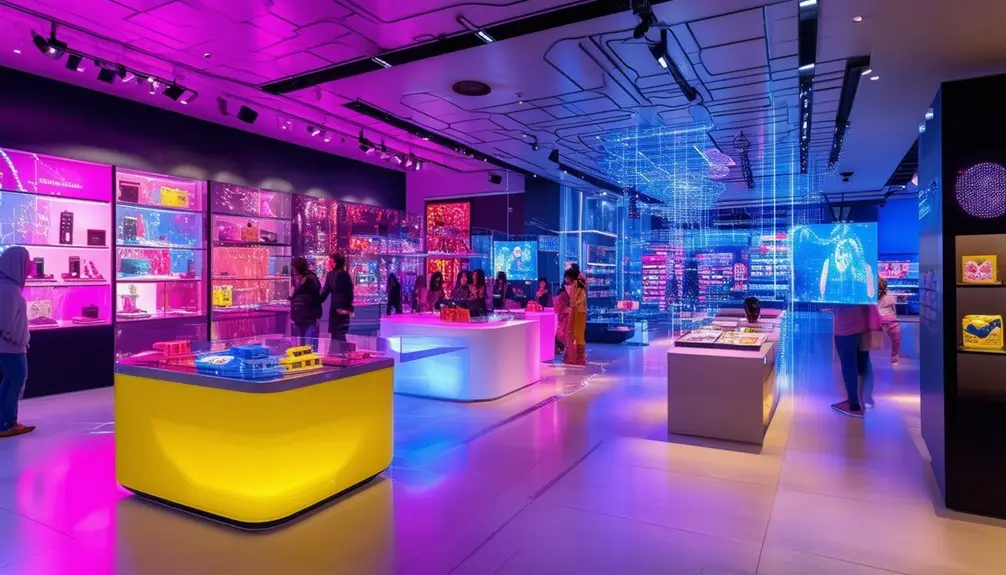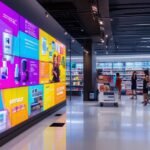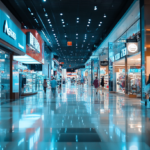Interactive display technology can revolutionize your retail business by boosting customer engagement up to 50%. These displays—ranging from touchscreens to virtual mirrors—offer personalized shopping experiences that drive sales and enhance brand awareness. Retailers leveraging interactive displays see sales increase by up to 30% and enjoy a 20% ROI boost. These technologies also capture valuable customer data, enabling personalized recommendations that lift conversion rates by 70%. By integrating smart retail displays into your strategy, you can transform customer interactions and stay ahead in a competitive market. Discover how these technologies can elevate your retail performance and customer satisfaction.
Key Takeaways
- Boosts customer engagement by up to 50% through interactive touchscreens and personalized experiences.
- Enhances brand visibility and awareness by attracting and educating customers with dynamic content.
- Drives sales growth and increases ROI with personalized recommendations and impulse purchase opportunities.
- Provides valuable customer data for tailored marketing strategies and strategic decision-making.
- Transforms retail spaces into immersive environments with technologies like virtual mirrors and beacon technology.
Benefits of Interactive Displays
Interactive displays can increase customer engagement by 50%, making them a powerful tool for enhancing brand awareness and driving sales growth. By integrating interactive retail displays, you can capture customer interest and encourage impulse purchases. These displays allow you to collect valuable customer data, which can be used to refine your marketing strategies and offer personalized recommendations.
Real-time metrics tracking provided by interactive displays offers direct insights into customer behavior. This data enables you to adapt quickly and efficiently, ensuring your marketing strategies are always relevant and impactful. Personalized recommendations driven by customer data enhance the shopping experience, fostering greater customer satisfaction and loyalty.
Interactive retail displays significantly contribute to sales growth by creating an engaging and immersive shopping environment. When customers interact with these displays, they are more likely to spend additional time in your store and make unplanned purchases. This not only boosts immediate sales but also cultivates a stronger connection with your brand.
What Is an Interactive Display?
Understanding the mechanics behind these engagement-boosting tools, an interactive display is a technology that allows consumers to engage with content through touch, gesture, or other interactive means. These displays are designed to educate, attract, and inform customers about products or services in a dynamic and engaging way. In retail businesses, interactive displays can enhance customer engagement to a large extent, promoting products more effectively and creating visually appealing experiences.
Interactive displays offer numerous advantages to retail businesses:
- Increased Engagement: Customers are more likely to engage with content that they can interact with, leading to longer in-store time and higher conversion rates.
- Enhanced Brand Visibility: Interactive displays make your brand stand out, especially in technology and electronics sectors where customers expect cutting-edge experiences.
- Data Collection: These displays can capture valuable customer data, enabling better marketing strategies and potentially increasing sales.
Data shows that interactive display technology can improve conversion rates and create memorable experiences for customers. By offering a hands-on experience, you’re not just selling a product; you’re providing an experience that fosters customer loyalty. In the competitive retail landscape, utilizing interactive displays can be a game-changer in boosting engagement and driving business growth.
Types of Interactive Displays
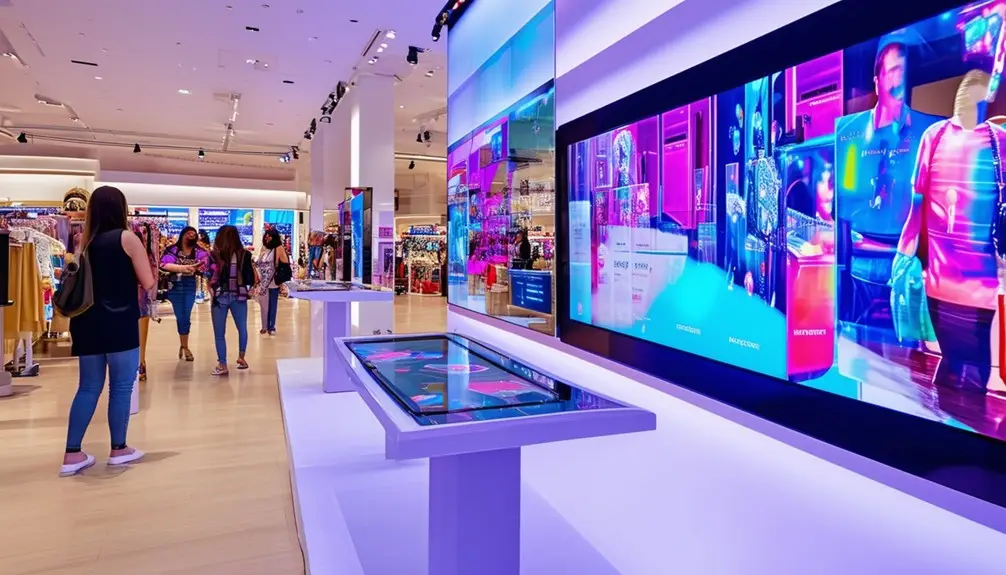
Retailers have a variety of interactive displays at their disposal, including touchscreens, virtual mirrors, beacon technology, robotic POSM, and RFID tags, each offering unique ways to enhance customer engagement and drive sales. Touchscreens serve as versatile smart displays, allowing customers to browse products, check prices, and access personalized recommendations. Virtual mirrors, like The Magic Mirror by Rebecca Minkoff, enable shoppers to try on clothes virtually, enhancing the interactive store experience.
Beacon technology uses small devices to send targeted promotions to customers’ smartphones, creating a seamless retail environment. Robotic POSM, such as Shelfobot by Tokinomo, captures attention with dynamic retail signage and interactive content. Meanwhile, RFID tags streamline inventory management and provide real-time data on product movement, benefiting both retailers and customers.
Examples like Amazon Go Stores demonstrate how integrating these smart retail displays can revolutionize physical stores, offering convenience through cashier-less checkouts. Nike Fit uses advanced technology to offer precise shoe sizes, reducing return rates. By incorporating these interactive displays, retailers can transform their retail environment, boost customer satisfaction, and leverage data analytics for improved decision-making. Test out these smart displays to find the right fit for your store.
Shopper Insights
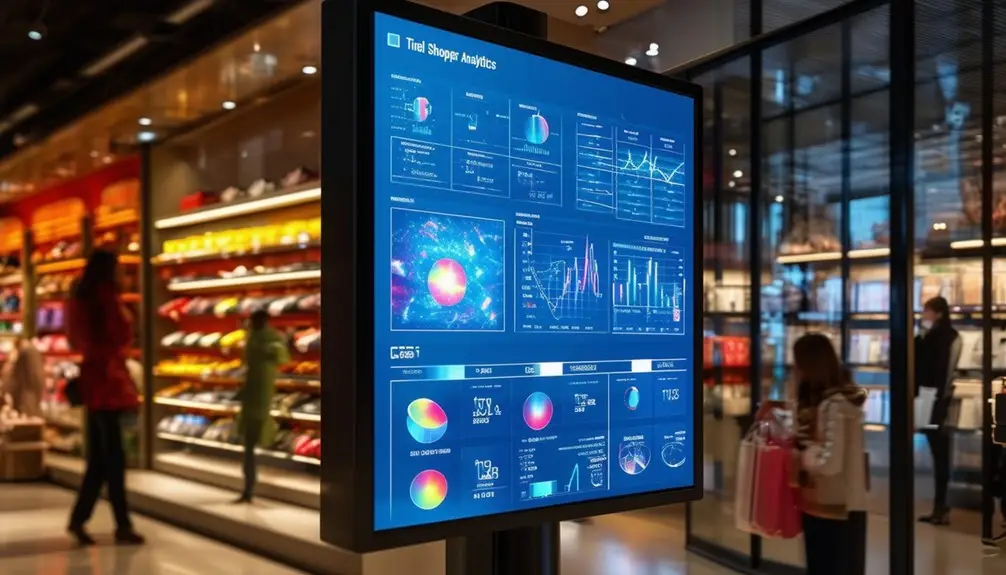
Gaining a deep understanding of shopper insights can be a game-changer for retail businesses, offering data-driven revelations about customer behavior and preferences that drive strategic decisions. By analyzing shopper insights, you can identify patterns in customer behavior, enabling you to optimize product placement, pricing, and marketing strategies within retail environments. This not only boosts in-store shopping experiences but also enhances customer engagement and loyalty.
Accessing detailed shopper insights allows you to tailor your offerings to align with customer preferences, thereby increasing retail performance. For instance, understanding which products are frequently viewed but not purchased can inform adjustments in merchandising or promotional tactics. Additionally, webinars focusing on shopper insights provide in-depth analysis and case studies, equipping you with actionable knowledge to stay competitive and adapt to evolving consumer trends.
Consider these key benefits of leveraging shopper insights:
- Enhanced Customer Engagement: Personalize the shopping experience based on data-driven customer preferences.
- Optimized Retail Performance: Make informed decisions on product placement and pricing to maximize sales.
- Competitive Edge: Stay ahead of market trends by continually adapting to consumer behavior.
Smart Retail Displays
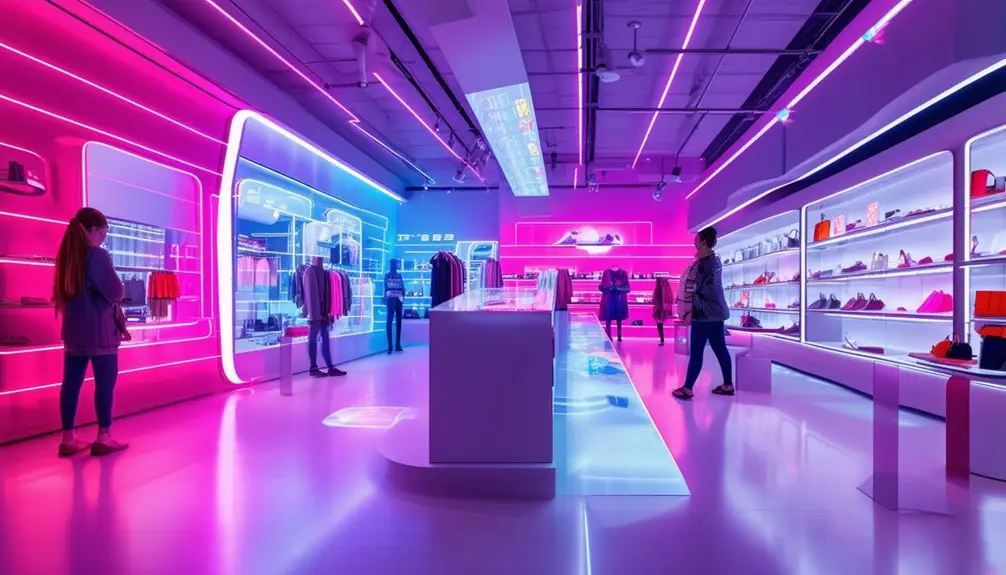
You’ll find that smart retail displays, such as interactive touchscreens and virtual mirrors, can increase customer engagement by up to 50%, directly boosting sales and fostering brand loyalty. These technologies, showcased in Amazon Go Stores and Nike Fit, revolutionize retail spaces by personalizing customer experiences and offering valuable data analytics insights. Integrating these displays not only transforms how customers interact with products but also provides you with actionable data to refine your marketing and sales strategies.
Types of Smart Displays
Smart retail displays, such as interactive touchscreens and virtual mirrors, are transforming the retail landscape by driving customer engagement and providing valuable data analytics. These interactive display solutions allow retailers to create enhanced customer experiences and implement effective in-store marketing strategies. Let’s take a closer look at the types of smart displays revolutionizing the industry:
- Interactive Touchscreens: These displays offer a dynamic way for customers to explore products, check availability, and even make purchases. Interactive touchscreens can be used for targeted advertising and gathering customer preferences.
- Virtual Mirrors: Mainly used in apparel stores, virtual mirrors let customers try on clothes virtually. This technology not only increases customer satisfaction but also collects data on popular styles and trends.
- Beacon Technology: Beacons can send personalized promotions and updates to customers’ smartphones as they navigate through the store, providing a highly customized shopping experience.
Retailers like Amazon Go and Nike Fit are already leveraging these smart displays to stay ahead. By integrating digital signage and RFID tags into their strategies, they’re able to offer a seamless shopping experience while gathering critical data. Testing and choosing the right solutions can significantly enhance your store’s customer engagement and marketing effectiveness.
Benefits of Integration
Integrating smart retail displays into your store can enhance customer engagement by 50%, driving both sales and customer satisfaction through personalized and interactive experiences. These smart displays create a more engaging shopping environment by offering tailored recommendations, virtual try-ons, and real-time promotions. The benefits of integration are significant, as they not only elevate customer engagement but also provide actionable data analytics that help you refine your marketing strategies.
Smart retail displays like interactive touchscreens, virtual mirrors, and RFID tags enable a level of interactive shopping that traditional setups can’t match. They provide personalized experiences that make customers feel valued and understood. By analyzing the data collected from these interactions, you can gain insights into customer preferences and behavior, allowing you to make more informed business decisions.
Here’s a quick overview of the benefits:
| Benefit | Description | Impact |
|---|---|---|
| Enhanced Customer Engagement | Increases interaction by 50% | Higher sales and satisfaction |
| Personalized Experiences | Tailored recommendations and promotions | Improved customer loyalty |
| Data Analytics | Actionable insights from customer interactions | Better marketing strategies |
| Interactive Shopping | Engages customers through advanced technology | Increased foot traffic |
| Innovative Solutions | Tests new tools for strategic enhancements | Drives overall business growth |
Revolutionizing Retail Spaces
Revolutionizing retail spaces, smart retail displays like interactive touchscreens and virtual mirrors can increase customer engagement by up to 50%, driving both sales and brand loyalty. By incorporating these technologies, you’re not just offering a product but an immersive, personalized experience that keeps customers coming back.
Smart retail displays such as beacon technology and RFID tags provide real-time data analytics, giving you insights into customer behavior. This data can be leveraged to tailor marketing strategies and optimize inventory management, ensuring you’re always one step ahead in meeting consumer demands.
Consider this:
- Amazon Go Stores: Seamless checkout experience with no lines, enhancing customer satisfaction.
- Nike Fit: Uses AR to help customers find the perfect shoe size, boosting purchase confidence.
- Shelfobot by Tokinomo: A robotic POP display that engages customers directly, increasing product interaction.
Interactive displays transform retail spaces into dynamic environments where customers feel valued. By personalizing experiences, you’re not only enhancing engagement but also driving sales. The integration of smart retail displays is a strategic move that offers a significant competitive edge, ensuring your business remains relevant in an ever-evolving market.
Enhancing Customer Experience
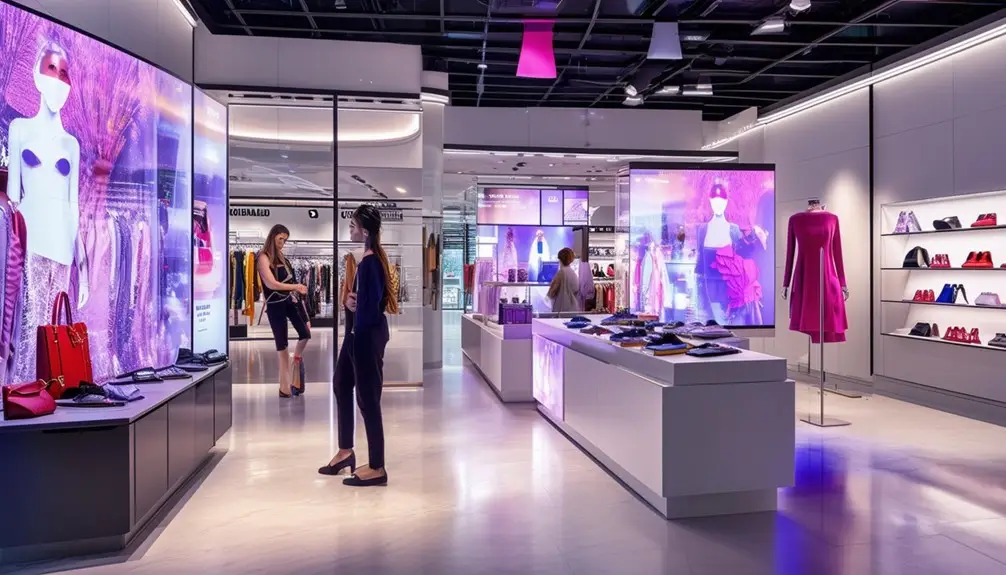
Leveraging interactive display technology can enhance the customer experience by increasing engagement, personalization, and satisfaction. By digitizing retail experiences, interactive displays make shopping more engaging. Studies show they can boost customer engagement by up to 50%. This isn’t just about flashy screens; it’s about creating a dynamic, interactive environment that draws customers in.
Personalization and customization are key aspects. Interactive displays allow you to tailor experiences to individual preferences, leading to higher customer satisfaction. Imagine a virtual mirror that suggests outfits based on your past purchases or a touchscreen that helps you find products faster. These features make shopping more enjoyable and efficient.
Data analytics play an essential role here. Interactive displays collect valuable insights into customer behavior and preferences. This data helps you understand what your customers want, enabling you to make informed decisions that enhance their shopping experience.
Here’s a snapshot of how interactive display technology can revolutionize retail experiences:
| Aspect | Impact on Customer Experience | Data-Driven Insights |
|---|---|---|
| Digitizing Retail Experiences | Boosts customer engagement by 50% | Tracks interaction patterns |
| Personalization and Customization | Increases customer satisfaction | Analyzes individual preferences |
| Data Analytics | Provides valuable insights | Informs targeted marketing strategies |
Boosting Sales and ROI
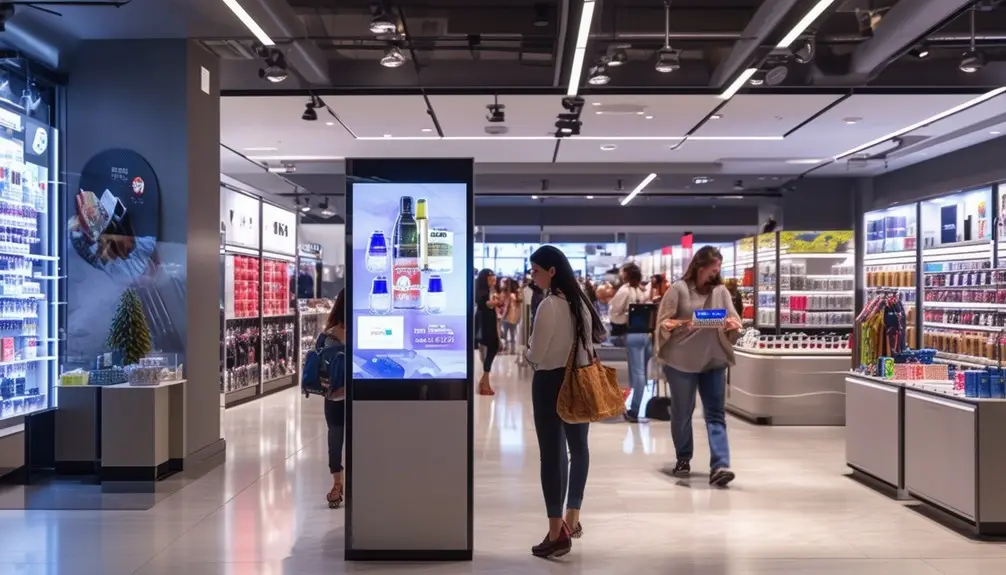
Interactive display technology can greatly boost sales and ROI for retail businesses by driving customer engagement and personalized shopping experiences. Studies show that interactive displays can increase sales by up to 30%, providing a substantial revenue boost. This technology’s ability to offer personalized recommendations plays an essential role in converting casual browsers into buyers, with conversion rates soaring by 70%.
Utilizing data analytics from interactive displays allows you to understand customer behavior and preferences better, leading to informed decisions that maximize profits. With the average ROI increase standing at 20%, it’s evident that investing in these displays can be a game-changer for your retail business.
Interactive displays encourage impulse purchases, significantly improving your bottom line. Customers are more likely to make unplanned purchases when they’re engaged and informed by dynamic, real-time information.
Conclusion
You might think interactive displays are just a fancy gimmick, but data proves otherwise. They greatly enhance customer experience and drive sales. By offering real-time shopper insights, these smart retail displays let you tailor promotions and product placements more effectively. The result? A measurable boost in ROI. So, don’t overlook the potential of this technology—it’s an investment that pays off in both customer satisfaction and your bottom line.
Frequently Asked Questions
What Is Interactive Retail Display?
An interactive retail display is a technology-driven solution that engages customers, educates them about products, and promotes sales. It boosts customer engagement by 50%, drives impulse purchases, and collects valuable data for retailers.
What Is Display System in Retail Industry?
Display systems in retail deliver dynamic digital engagement, driving customer interactions and sales. They provide personalized experiences through technologies like touchscreens, RFID, and beacons, offering valuable insights and data analytics to optimize your retail strategy.
How Do Retail Stores Display Products?
You display products through custom floor displays, retail signage, end caps, pallet displays, and power wings. These methods enhance visibility and engagement, driving sales. Data shows strategic placement and appealing design greatly boost customer interaction and purchase rates.
How Do You Create an Effective Retail Display?
To create an effective retail display, analyze shopper behavior, incorporate eye-catching designs, and strategically place products to boost visibility. Use data: 85% of decisions are in-store, and good displays can increase sales by 30% and foot traffic by 20%.

